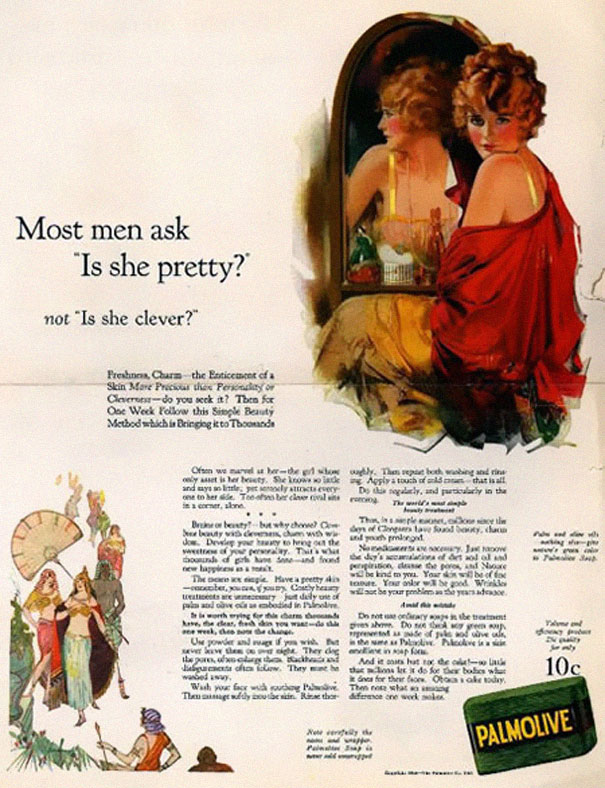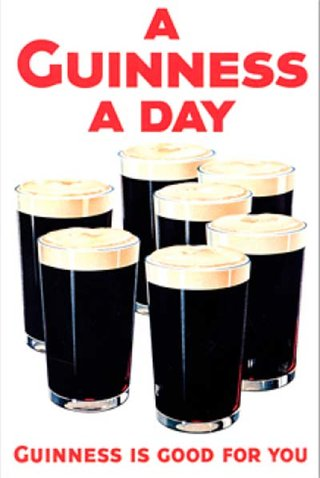Answers
Jul 26, 2019 - 06:58 AM

1924: Is She Pretty?
Today, the notion that women are valued for their looks over other qualities still plays a role in many ads - even as mainstream brands try to stay relevant by flouting this convention. However, there was a time when no one questioned this line of marketing, and it was even more shockingly blatant then.
Palmolive’s suggestion that men are more interested in pretty women than clever women seems like a recipe for relationship disaster (as well as being misogynistic). But it fit perfectly well with the personal care product ads of its time.

1929: Guinness Is Good for You
Today, we take it for granted that ads often bend the truth to get our attention. However, we also know that ads can’t make outright false claims - they can only suggest at those claims.
But that wasn’t always the case. It wasn’t until the 1930s that cultural outrage started prompting the government to make blatant lies illegal in ads. Today, it seems comical to see claims like “Guinness is good for you” in an ad. But for a period of time, ads could say anything - and people often believed those baseless claims. It took time for today’s widespread mistrust of advertising to become the norm.

1947: A Diamond Is Forever
At first glance, this De Beers ad doesn’t look strikingly different from modern diamond ads. However, it gets more interesting when you realize that diamonds as engagement (or even romantic) jewelry didn’t become a mainstream trend until the late 1940s. De Beers, in fact, entirely manufactured this trend using ads like these.
De Beers simply wanted to sell more diamonds, and the campaign worked better than almost any ad strategy in history. The company was concerned about falling worldwide diamond prices, so they manufactured a new source of demand. That demand has kept diamonds expensive in the decades since - even though the gems aren’t inherently all that valuable. This is compelling proof of the power ads have to change culture.
1954: The Marlboro Man
The iconic Marlboro Man made his first debut in 1954, and passed through many different iterations before the brand ended the campaign in 1999. But can you recall the last time you saw a cigarette ad?
Cigarette ads got banned from TV and radio in 1971, well before smoking fell out of favor in the popular consciousness. While cigarette ads can still appear in print, they’re far less common than they once were, and cigarette companies have had a hard time recapturing the iconic status of their former ads - in part because they’re no longer allowed to use either humans or cartoons in their ads.
1960: Lemon
Today’s ads are arguably more quirky, self-aware, and creative than ever before. Thanks to the internet, advertisers have to compete with more noise to grab customers’ attention, and they have a shorter window of time to do it in.
But there was a time when ads were mostly straightforward and literal, even kind of boring. People readily accepted this simple ad copy, because no one had tried anything different yet. Then, “Lemon” came along.
This Volkswagon ad, alongside the even more famous “Think Small” one, marks perhaps the first time an ad successfully used self-deprecation. It was akin to breaking the fourth wall: showing an awareness of the audience’s perception in a dramatically straightforward way. And it worked. Thanks to Volkswagon, the people who didn’t love mass consumer culture now had clever, ironic, playful ads that spoke directly to them.

1977: Simplicity Is the Ultimate Sophistication
Apple provides another example of a brand that was way, way ahead of its time in its advertising. While simplicity is now a given in many ads, especially for consumer tech products, this 1977 slogan completely broke trends - as Apple would continue to do time and again in the decades that followed.
Today, the idea that simplicity is sophisticated seems so obvious that this ad really wouldn’t ring true. But at that time, this slogan made a unique statement in a world of busy advertising. It was especially daring as a way to sell a complicated, little-understood product: the personal computer. Apple’s suggestion that simplicity is desirable helped usher in today’s minimalist design trend, which extends beyond ads to everything from clothing to packaging. However, even Apple went through several confusing, convoluted ad designs over the years before returning to the beauty of simplicity.
Oct 04, 2019 - 04:51 PM
They aren't as fun as some ive seen, we used to have a big box of old newspapers dating all the way back to the late 1800s, there were countless ads for booze and cigs etc, some which seemed to even show children partaking.
but going back even further to the victorian era things get even crazier one i saw was something like "Dr Allmans No 47 Throat Pastilles with Heroin and Cocaine" thats right people got a bit of a sore throat in victorian england then smack and coke were your remedy! (dont get me wrong itd be effective but a just tad extreme)






Add New Comment